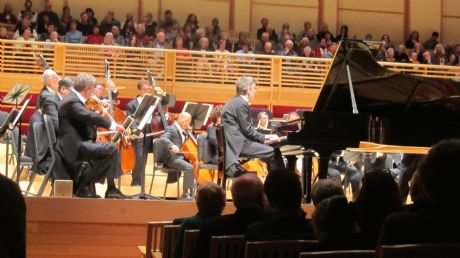|
Symphony
FROM THE NEW WORLD TO THE OLD WORLD
by Peter Lert
Saturday, June 14, 2025
Chamber
MC2 DUO RECITAL CLOSES 222'S SEASON
by Terry McNeill
Saturday, June 14, 2025
Choral and Vocal
CANTIAMO SONOMA'S LUSCIOUS A CAPELLA SINGING IN SEASON ENDING CONCERT
by Pamela Hicks Gailey
Sunday, June 8, 2025
Symphony
SRS SEASON ENDS WITH RESOUNDING TA-TA-TA-BANG
by Terry McNeill
Sunday, June 1, 2025
Symphony
YOUTHFUL VIRTUOSITY ON DISPLAY AT USO'S MAY CONCERTS
by Peter Lert
Saturday, May 17, 2025
Symphony
MYSTICAL PLANETS AND LIVELY GERSHWIN ORTIZ AT FINAL SRS CONCERT
by Peter Lert
Sunday, May 4, 2025
Symphony
VSO'S CONCERT MUSIC OF TIME, MUSIC OF PLACE
by Peter Lert
Sunday, April 27, 2025
VOCAL ELEGANCE AND FIRE AT THE 222'S RECITAL APRIL 26
by Pamela Hicks Gailey
Saturday, April 26, 2025
CANTIAMO SONOMA SINGS AN INSPIRED GOOD FRIDAY MOZART REQUIEM CONCERT
by Pamela Hicks Gailey
Friday, April 18, 2025
DRAMATIC SHOSTAKOVICH SYMPHONY CLOSES PHILHARMONIC'S 25TH SEASON
by Terry McNeill
Sunday, April 13, 2025
|
 |
 San Francisco Symphony and Peter Serkin (piano) Feb. 12 (N. Bell Photo) |
BOLD OPERATIC AND SYMPHONIC CONTRASTS IN SF SYMPHONY CONCERT
by Nicki Bell
Thursday, February 12, 2015
Pianist Peter Serkin and San Francisco Symphony Laureate conductor Herbert Blomstedt pulled musical extremes together on Feb. 12 in Weill Hall Symphony concert where artistic experience was a defining factor. From the warmth and humor of Mozart’s F Major Piano Concerto, K. 459, to the turmoil, drama and final ecstasy of the Sibelius Second Symphony, the music flowed with richness and resonance.
Mozart 19th Concerto from 1784 is Mozart at his height of popularity. Its beginning is permeated with a “Magic Flute” flavor, Pamino and Tamino's ancestors, with its warmth, humor, flirtatious mischief. Mr. Serkin played with gorgeous, luscious tone, his phrases beautifully voiced and shaped. With the
acoustics of the hall, the clarity of the instruments is exciting, a lush string sound, and the winds shone in their changing of the mood colors. The three movements are an opera unfolding in sound. One interesting aspect of the pianist’s playing was his use of ersatz vibrato on an ending note and then to lift his right arm into the air, still moving with a waving tremolo. This seems to be derived Mr. Serkin’s teacher father, Rudolf, but was also a trait from the Schnabel family of musicians.
Mr. Blomstedt was hidden behind the piano lid during the Mozart, but with the Sibelius it was a shock to see him conducting without either score or baton. He is 88 and seemed calmly commanding, thoroughly in his element. From the chamber orchestra size in the Concerto, the San Francisco Symphony doubled in size for the Sibelius Second Symphony in D Major, Op. 43, with a full complement of brass, percussion, winds and extra strings.
This behemoth work was built primarily out of what has been called "handfuls of thematic nuclei" that evolve into complete structures. The melodic "do-re-mi" of the beginning is used throughout and by the end has expanded and morphed as an acorn into an oak tree. Each of the four movements are filled with intense contrasts. This is a large scale work that premiered in Helsinki in 1902 with the composer conducting.
There is an apocalyptic character to the piece and the nearly full audience in Weill was was bathed in magnificent and monumental sound. From oboe laments to full-throttle strings, fabulous double bass pluckings to woodwind choirs, pastorale interludes giving way to the brass, the dramatic themes and emotional turmoil roll throughout the four movements to a grand, heroic fortissimo conclusion,
People from Finland have said that “there is something about his music (Jean Sibelius), at least for us Finns, that leads us to ecstasy, almost like a shaman with his magic drum.” Mr. Blomstedt and the virtuoso San Francisco Symphony were the audience’s shaman in this prodigious concert.
|

